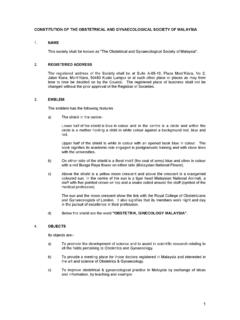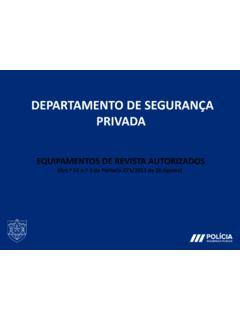Transcription of SCOPE Work Package 7 Quality Management Systems
1 SCOPE work Package 7. Quality Management Systems Quality Planning and Quality Objectives 2016. SCOPE work Package 7. Quality Management Systems Quality Planning and Quality Objectives Contents Acknowledgments 3. 1. Introduction 4. Purpose of the document 4. Definitions and abbreviations 4. Background 6. Context and SCOPE of the toolkit item 7. 2. Introduction to Quality planning and the selection of Quality objectives 9. The concept and significance of planning 9. Business planning, Quality planning and their relationship 9. Levels of planning 10. Quality policy 11. Quality objectives and their selection 14. Measurement of ( Quality ) objectives, setting of indicators 15.
2 Quality objectives defined for PV activities 17. The Quality planning process 18. Monitoring and evaluation 20. Communication and staff involvement 21. 3. Case studies 22. Agency for Medicinal Products and Medical Devices (HALMED), Croatia 23. Medicines Evaluation Board (MEB), Netherlands 28. National Authority of Medicines and Health Products (INFARMED), Portugal 35. Medicines and Healthcare Products Regulatory Agency (MHRA), United Kingdom 39. 4. Summary and conclusion 45. 5. Additional information 46. Effectiveness versus Efficiency 46. SWOT analysis (Strengths, Weaknesses, Opportunities and Threats) 46. OGSM method (Objectives, Goals, Strategies and Measures) 47.
3 BSC (Balanced Scorecard) 47. 2. SCOPE work Package 7. Quality Management Systems Quality Planning and Quality Objectives Acknowledgments Author Melinda P lfi This document has been developed and approved by all WP7 active partners (BG, ES, HU, IT, PT and UK). The author would like to thank all colleagues who participated in the online survey of WP7 and thus, contributed to the identification of areas of Quality Management that needed further explanation, and provided good practices to share across EU MSs. Furthermore, the author would like to express special thanks to colleagues from the HALMED (HR), MEB (NL), INFARMED.
4 (PT) and MHRA (UK) who participated in the follow-up activities and were willing to provide detailed explanation and share their extensive experience on the topic of this document. 3. SCOPE work Package 7. Quality Management Systems Quality Planning and Quality Objectives 1. Introduction Purpose of the document The purpose of this document is to introduce a specific process of Quality Management to phar- macovigilance (PV) assessors and any interested parties at National Competent Authorities (NCAs): Quality planning and the selection and Management of Quality objectives. The document covers basic definitions and introduces the topic through several practical examples from PV as collected by an online survey and through written and face-to-face follow-up activities from NCAs participating in the SCOPE (Strengthening Collaboration for Operating Pharmacovigilance in Eu- rope) project.
5 The purpose is to share experience with and disseminate good practice across Member States (MS) and to increase the level of awareness of PV assessors and interested staff on specific areas of Quality Management instead of providing exhaustive guidance. Practices described in this document may not cover all relevant issues and may not be suitable for every NCA. It is at the discretion of each NCA whether to consider any practices presented in this document relevant to their work , and there is no obligation to adopt any practices. Definitions and abbreviations Terminology Description ADR Adverse Drug Reaction BEMA Benchmarking of European Medicines Agencies BSC Balanced Scorecard CHMP Committee for Medicinal Products for Human Use CMDh Coordination Group for Mutual Recognition and Decentralised Procedures.
6 Human DHPC Direct Healthcare Professional Communication EPITT European Pharmacovigilance Issues Tracking Tool EMA European Medicines Agency eRMR electronic Reaction Monitoring Report EU European Union/Europe GVP Guideline on Good Pharmacovigilance Practices HALMED Agency for Medicinal Products and Medical Devices of Croatia HCP Healthcare Professional 4. SCOPE work Package 7. Quality Management Systems Quality Planning and Quality Objectives Terminology Description INFARMED National Authority of Medicines and Health Products (PT). ISO International Organisation for Standardisation IMPACT Implementing Pharmacovigilance Actions team IT Information Technology MAH Marketing Authorisation Holder MEB Medicines Evaluation Board (NL).
7 MHRA Medicines and Healthcare products Regulatory Agency (UK). KPI Key Performance Indicator MS Member State NCA National Competent Authority OGSM Objectives, Goals, Strategies and Measures PDCA Plan-Do-Check-Act PRAC Pharmacovigilance Risk Assessment Committee PV Pharmacovigilance QMS Quality Management system SCOPE Strengthening Collaboration for Operating Pharmacovigilance in Europe SOP Standard Operating Procedure SMRM Signal Management Review Meeting SWOT Strengths, Weaknesses, Opportunities and Threats VRMM Vigilance and Risk Management of Medicines (MHRA). WIN work Instruction WP work Package 5. SCOPE work Package 7.
8 Quality Management Systems Quality Planning and Quality Objectives Background The effective and efficient operation of any organisation, organisational unit, Management system or subsystem is primarily dependent on a consistent planning process. Goals relevant for the strategic direction of the organisation have to be carefully planned together with measurable indicators to check for the realisation of targets within a defined timeframe, and results have to be fed back to the system for correction and improvement. Furthermore, planning ensures that available resources that are usually limited or restricted in nature are used in the most effective and efficient manner.
9 Although NCAs are operating in the public sector, which makes them dif- ferent from the private sector in many ways, a key sense of direction, good strategy and effective implementation of strategic plans is essential to achieve success. Quality Management adds a further dimension by ensuring that the organisation works in com- pliance with statutory and internal requirements, makes every effort to satisfy the needs and expectations of its customers, aims at continuous improvement of its services and maximises its performance. Introduction of Quality Management is the decision of the top Management of an organisation and an effective PV Quality system cannot function in isolation, but rather as an integral part of the global organisational Quality system .
10 In public organisations, Quality is often defined as the minimum that a supervisory body ( government) demands, and cost reduction is usually more important than Quality improvements which may not lead to an increase in customer Nevertheless, based on the results of the online survey conducted by WP7, some NCAs who decided to follow available international Quality standards ( ISO 9001 and others) to assist them in the development of their Quality Systems , benefited from such an approach considering both the global organisational and the PV Quality Furthermore, GVP Module I is consistent with the general principles of the ISO 9000 Standards on good Quality Management practices, specifically the ISO 9001:2008.





